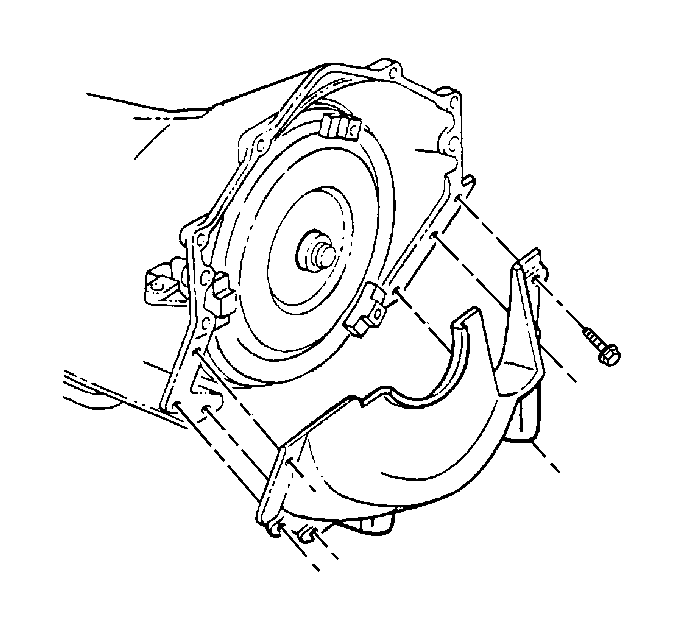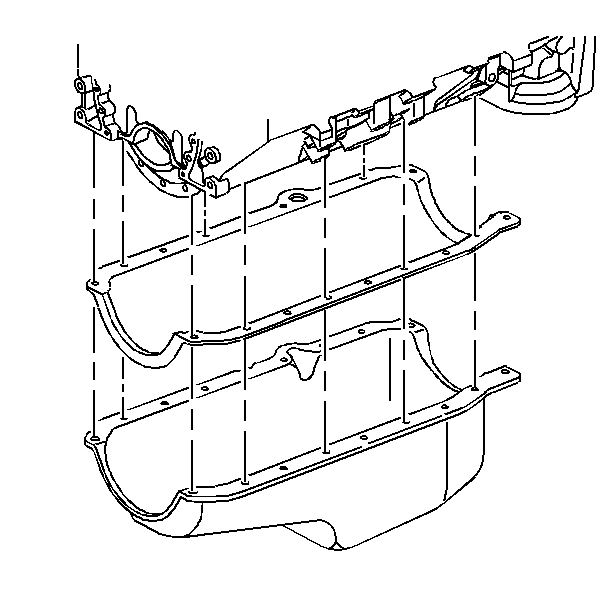Removal Procedure
Important: Do not raise the engine by the crankshaft balancer to perform this service procedure. Damage to the crankshaft balancer or the crankshaft may occur.
- Open the hood.
- Disconnect the battery negative cable from the battery. Refer to Battery Cable in Engine Electrical.
- Remove the oil level indicator and tube from the engine. Refer to Oil Level Indicator and Tube Replacement .
- Raise the vehicle. Refer to Lifting and Jacking the Vehicle in General Information.
- Drain the crankcase. Refer to Engine Oil and Oil Filter Replacement in Engine Mechanical.
- Remove the starter from the engine block. Refer to Starter Motor Replacement in Engine Electrical.
- Remove the flywheel inspection cover if equipped.
- Remove the oil filter and adapter (4WD) if equipped. Refer to Oil Filter Adapter and Bypass Valve Assembly Replacement .
- Remove the oil cooler line retainer from the retaining bracket. Refer to Engine Oil Cooler Hose/Pipe Replacement in Engine Cooling.
- Remove the transmission from the vehicle.
- Remove the clutch if equipped. Refer to Clutch Assembly Replacement in Clutch.
- Remove the flywheel from the crankshaft. Refer to Engine Flywheel Replacement .
- Remove the oil pan bolts from the engine block.
- Remove the oil pan from the vehicle.
- Remove the oil pan gasket from the engine block.
- Remove the oil from the sealing surfaces. Refer to Engine Block Cleaning and Inspection .
Caution: Before servicing any electrical component, the ignition and start switch must be in the OFF or LOCK position and all electrical loads must be OFF, unless instructed otherwise in these procedures. If a tool or equipment could easily come in contact with a live exposed electrical terminal, also disconnect the negative battery cable. Failure to follow these precautions may cause personal injury and/or damage to the vehicle or its components.

Important: DO NOT lift the engine by the crankshaft balancer to aid in removing the oil pan from the engine block. Damage to crankshaft balancer or crankshaft could occur.
| • | For the automatic transmission. Refer to Transmission Replacement or Transmission Replacement in Transmission/Transaxle. |
| • | For the manual transmission. Refer to Transmission Replacement in Transmission/Transaxle. |

Installation Procedure
Important: The oil pan gasket is reusable. Replace only if the gasket is damaged.
- Install the oil pan gasket on the oil pan.
- Install the oil pan gasket and oil pan to the engine block.
- Install the oil pan bolts to the engine block.
- Install the clutch assembly to the flywheel. Refer to Clutch Assembly Replacement in Clutch.
- Install the flywheel to the crankshaft. Refer to Engine Flywheel Replacement in Engine Mechanical.
- Install flywheel inspection cover to the transmission.
- Install the transmission in the vehicle.
- Install the starter to the engine block. Refer to Starter Motor Replacement in Engine Electrical.
- Install oil cooler line to the retainers. Refer to Engine Oil Cooler Hose/Pipe Replacement in Engine Cooling.
- Install the oil filter adapter (4WD) to the cylinder block if equipped. Refer to Oil Filter Adapter and Bypass Valve Assembly Replacement .
- Lower the vehicle. Refer to Lifting and Jacking the Vehicle in Genreal Information.
- Install the oil level indicator and tube. Refer to Oil Level Indicator and Tube Replacement .
- Fill the crankcase with new engine oil. Refer to Engine Oil and Oil Filter Replacement .
- Connect the battery negative cables to the battery. Refer to Battery Cable in Engine Electrical.
- Close the hood.

Notice: Use the correct fastener in the correct location. Replacement fasteners must be the correct part number for that application. Fasteners requiring replacement or fasteners requiring the use of thread locking compound or sealant are identified in the service procedure. Do not use paints, lubricants, or corrosion inhibitors on fasteners or fastener joint surfaces unless specified. These coatings affect fastener torque and joint clamping force and may damage the fastener. Use the correct tightening sequence and specifications when installing fasteners in order to avoid damage to parts and systems.
Tighten
Tighten the bolts to 25 N·m (18 lb ft).

| • | For the automatic transmission. Refer to Transmission Replacement or Transmission Replacement in Transmission/Transaxle. |
| • | For the manual transmission. Refer to Transmission Replacement in Transmission/Transaxle. |
